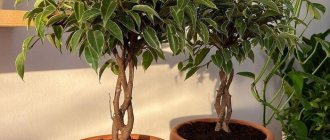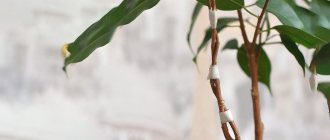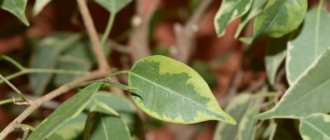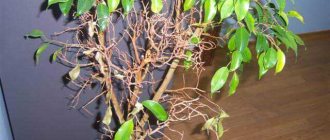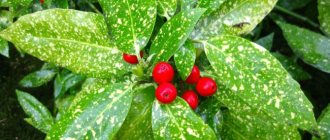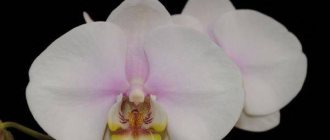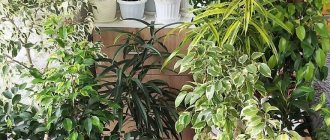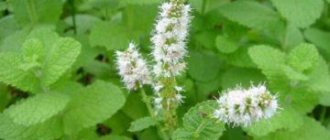floravdome.ru > Decorative foliage > Top 22 Popular varieties of ficus benjamina photos and names
Ficus Benjamina is a popular indoor decorative foliage plant native to South Asia and Northern Australia. In its homeland, ficus grows into multi-meter trees and in warm countries is widely used for landscaping parks and squares.
In our climate, heat-loving plants can grow outside only in the summer, but in the winter they must be brought indoors. But they have taken root well in apartments and offices, growing, of course, not ten meters, but under favorable conditions reaching a height of two to three meters.
Ficus benjamina in nature
The popularity of the ficus benjamina was brought not only by its bright “appearance”, but also by the ease of caring for the plant and its rapid growth, as well as the ability to form an attractive indoor tree to your liking.
You can read more about plant care in a separate article . Here we recall the basic rules.
Caring for Ficus Benjamin at home
- The ficus is placed in a bright place, protected from direct sunlight and drafts.
- The temperature that is comfortable for Ficus Benjamin is +20° - 25°, in winter it can be lowered to +18°.
- Water regularly, when the top layer of soil dries 2-5 cm (depending on the size of the plant and the depth of the pot). In winter, watering is allowed once a week.
- In spring and summer, ficus is fertilized once every two weeks - dark-leaved varieties with fertilizer for ornamental foliage plants, variegated varieties - with fertilizer with a predominance of potassium and phosphorus (to maintain variegation)
- For full, constant growth, it is recommended to replant ficus trees annually into larger pots, and for large specimens, to annually update the top layer of soil.
- To form the ficus and stimulate growth, it is recommended to prune the plant annually at the beginning of the growing season.
Ficus benjamina tree in the interior
Ficus benjaminima has so many varieties, differing in shape, size and color of leaves, that it is easy for an untrained gardener to get confused. Many of them are derivatives of the main variety and differ from it slightly - in shade or leaf size. Experienced flower growers can distinguish them.
But, fortunately, most varieties of Ficus Benjamin have significant differences from each other, which allows any gardener to choose a plant to their liking.
Let's look at the most popular and available varieties. For convenience, we will conditionally divide them into several groups according to the main characteristic features of their appearance.
- unpretentious varieties with green leaves that require minimal care;
- variegated ficuses , combining shades of green;
- variegated ficuses (variegated, combining green and white, cream colors);
— small-leaved ficus;
- ficuses with twisted , curly leaves, single-colored or variegated.
Ficus benjamina in the interior
Ficus transplantation and planting
Like any other plant, ficus needs the presented manipulations. Without them, it will not be as beautiful and lush as it should be. Therefore, the flower is replanted annually for the first time. Afterwards, the procedure is performed as needed - once every couple of years. Bushes that grow in large flowerpots should not be replanted; only the top layer of soil changes.
Ficus curly or some other variety is replanted at the very beginning of spring, when the flower is just beginning to “wake up”. At this point, the gardener will need to prepare a substratum and a container that is a couple of centimeters larger than the previous one.
First of all, a drainage layer is laid on the bottom, and it is checked whether there are special holes in the bottom of the container for aeration. If they are not there, then they should be done; the flowerpot cannot be used without special gaps.
It is better to replant using the transshipment method using an earthen clod, which is placed in a new pot. After this, the voids will need to be filled with pre-prepared soil mixture and the flower watered. For three weeks after the manipulation, irrigation and watering must be carried out daily.
If the plant has just been purchased, you should not replant it immediately. In this case, the features of caring for ficus Benjamin come down to allowing the plant to adapt to new conditions. It will be possible to carry out any manipulations with the flower no earlier than in 3-4 weeks.
In emergency cases, you can urgently transplant the ficus.
These cases are as follows:
- When leaves turn yellow en masse, and there is no apparent reason for the problem.
- When roots emerge from drainage holes.
- In case the soil is acidified.
- When the earth turned into a dry lump.
Unpretentious varieties of ficus benjamina with green leaves
Ficus, in general, is an unpretentious plant and causes almost no trouble to the owner. But some varieties are particularly different in this regard. These are, as a rule, natural varieties of ficus. At home, they grow well in partial shade, tolerate short-term drought without damage, and even, most often, recover from unfavorable factors.
Green-leaved varieties are not as demanding on lighting as variegated ones, which makes them indispensable for dimly lit rooms.
Ficus Exotica
Indonesian view from the island of Java. Drooping dark green glossy leaves with a wavy edge. An unpretentious ficus with an elegant appearance, easy to form, grows well even in partial shade. One of the most popular varieties.
Ficus benjamina Exotica (Ficus Exotica)
Ficus Danielle
Dark green shiny drooping leaves with a long sharp tip and a slightly wavy edge 5-6 cm long. Unpretentious, can grow in partial shade. It grows quickly and requires periodic shaping and pruning.
Ficus benjamina Danielle (Ficus Danielle)
Ficus Neon (Neon)
Drooping glossy leaves with a slightly wavy edge and a long sharp tip, bright green. Young leaves are golden-green.
Ficus benjamina Neon (Ficus Neon)
Ficus Esther
Outwardly similar to Neon, but the leaves do not have such a long elongated tip as Neon. The leaves are up to 5 cm in size, light green in color.
Ficus benjamina ester (Ficus ester)
Ficus Monique
A variety with a golden hue of rich green glossy leaves with a slightly wavy edge. The branches are drooping and form a dense crown. Tolerates partial shade well. Requires regular pinching and pruning to form a crown.
Has a variegated variety of Golden Monique.
Ficus Monique (Ficus Monique)
Ficus Naomi
Naomi is similar to the Monique variety, but the leaves are more wavy along the edges and much smaller (up to 5 cm).
Variety - Naomi Gold variety - light green leaves with dark streaks in the center of the leaf.
Ficus benjamina Naomi (Ficus Naomi)
Description of the plant
Ficus Benjamina came to us from the tropical rainforests of Southeast Asia. It is named after the British botanist who specialized in seed plants, Benjamin Daydon Jackson. It grows in India, Southern China, the Philippines, Malaysia and Northern Australia. This is an evergreen representative of the Mulberry family. In a warm, humid environment, the tree can grow up to 30 meters in height, overgrown with branched shoots.
The trunk of the plant is gray-brown with rare brown streaks. Young erect shoots quickly become lignified. There are almost no aerial roots. The branches are drooping, forming a dense spreading crown. The leaves of Ficus Benjamin are thin, leathery, lanceolate in shape, with entire outer margins. Their length in large varieties reaches 13 cm, and their width up to 6 cm. In small-leaved varieties, the dimensions are much more modest. The central vein of light green color is clearly visible. The leaves are glossy. Different varieties have their own color - from light green to dark, with white, cream and yellow spots. Many varieties have edging on the leaves. The tip of each leaf is drawn into a drip point, characteristic of this type of ficus. Excess water flows down it and falls on the leaves.
Ficus leaves are located on the branches in the same plane. They sit on flexible short petioles (up to 2 cm), thanks to which even with the slightest breeze you can hear their amazing rustling.
Under natural conditions, ficus benjamina blooms with insignificant flowers. It bears fruit with oblong or round inedible paired fruits (syconia) up to 2 cm in diameter. As the fruit ripens, the color changes from red to burgundy. At home, ficus does not bloom or bear fruit.
The rhizome of Ficus Benjamin goes deep into the soil, at a distance often comparable to the height of the tree. However, the surface roots are also well developed. For example, they can easily break through the asphalt and intertwine with the trunk into a dense, intricate sculptural group.
In European countries with a dry climate, ficus benjamina grows as a single-stemmed tree with drooping branches, and is far from gigantic in size. Everywhere it is grown as an indoor flower in beautiful flowerpots as an ornamental foliage plant.
Young shoots of the plant are flexible and easily grow together. Flower growers use these properties to give the plant an unusual shape. If you have a creative streak, try to create from your ficus a unique, unique specimen, for example, with a pigtail stem, or with a crown similar to a ball or dome. Or maybe you want to grow a ficus tree in the form of a bonsai tree. To do this, you only need a great desire, a little patience, ingenuity and time - and your flower will gradually acquire the desired appearance.
A little about the benefits
Ficus benjamina is one of the top five filter plants. They purify the air by absorbing toxic substances from it (formaldehyde, benzene, toluene and the like, emitted by modern furniture, clothing, gas and heating appliances, electronics) and releasing oxygen into it.
This may be interesting: Stromantha - home care
Ficus small-leaved
Small-leaved ficuses do not grow into large trees, but rather into tall bushes with a dense, lush crown. With proper pruning, you can give the ficus any desired shape; on small-leaved ficus it looks most impressive.
Ficus Natasha
A very popular variety among ficus growers. Small, up to 3 cm, deep green leaves are slightly bent along the central vein, and the tip of the leaf is slightly bent. Grows in a lush, dense bush. Unpretentious, but demanding of the basic rules of care - warmth, light, humidity, absence of drafts. Grows moderately quickly.
Ficus benjamina Natasha (Ficus Natasha)
Ficus Wiandi
Another small-leaved variety with leaves up to 3 cm. Unlike the similar variety Natasha, the trunk of Viandi does not grow straight, but randomly twisting, which is the highlight of this variety and allows the formation of unusual bonsai-type mini-trees using the trunk.
Ficus benjamina wiandi (Ficus wiandi )
Ficus Kinky
Small green leaves with a small light (from light yellow to light green) uneven edging along the edge. It grows as a low bush with a dense dense crown. It forms itself; additional pruning is required only to give it a certain shape.
Ficus Kinky (Ficus Kinky)
Ficus variegated green with green
Unusual and spectacular representatives of ficus Benjamin, combining in their colors two shades of green - bright, rich and dark. The differences between these varieties are determined by the size of the leaves and the total area of dark inclusions. As a rule, inclusions are not located randomly, but in a spot from the center of the sheet with uneven, clearly defined edges.
Ficus Anastasia
Quite large, up to 8 cm leaves with a slightly wavy edge. The color is rich green with an uneven bright yellow-light green border along the edge and a pronounced central vein of the same color.
Ficus benjamina Anastasia (Ficus Anastasia)
Ficus Golden Monique
A variegated variety of the Monique variety - bright green light leaves with a dark green uneven spot in the center.
Ficus Golden Monique
Ficus variegata white with green
The most striking and popular representatives of Ficus Benjamin are its variegated varieties. They are represented by many varieties - from ficus plants with leaves with a narrow light border along the edge to plants with almost completely white leaves.
Variegation does not at all mean that the flower is particularly capricious, but to preserve its decorative appearance, attention should be paid to lighting for the plant - daylight hours should be long and there should be a lot of light, at the same time, protection from direct sunlight is required. Any change in illumination will affect the color of the flower, so illumination is required in winter.
Fertilizers should be selected with a minimum amount of nitrogen and sufficient potassium and phosphorus.
As for general care, the preferences of a particular variety should be taken into account. There are unpretentious varieties that can easily withstand short-term hardships (low temperatures, drying out), and there are also whimsical varieties for which any change in the regime is detrimental.
Ficus Starlight
Almost completely white leaves with small chaotic dark green spots of varying sizes. The leaf is slightly curved along the central vein. Requires a lot of light, but does not tolerate direct sunlight. More thermophilic than many other varieties of ficus B. - the minimum temperature is not lower than +20o. Bright, spectacular and unusual variety.
Ficus benjamina Starlight (Ficus Starlight)
Ficus De Gantel
One of the most spectacular varieties - the leaves are almost white with small strokes of dark green from the central vein to the edges. Completely white leaves are found. Demanding about lighting and care.
Ficus benjamina De Gantel (Ficus De Gantel)
Ficus Curly
The leaves do not have a specific shape and color and can be straight, wavy or with a wavy edge with colors ranging from dark green to white, spotted, speckled and streaked with white over a green main background. Needs regular shaping.
Ficus Curly (Ficus Curly)
Ficus Fantasy
All leaves are of different colors (solid or variegated) and shapes, but less curled. This variety is often confused with Curly, from which it was developed, but this variety combines the characteristics of Curly and Danielle and has more solid green leaves.
Ficus benjamina Fantasy
Ficus Baft
Dark green leaves with a thin edge, almost white on mature leaves.
Ficus benjamina Baft (Ficus Baft)
Ficus Golden King
Large-leaved popular variegated variety. The leaves are up to 8 cm by 4 cm, light green in color with a golden-green uneven edging along the edge. Grows into a large tree.
Ficus Golden King (Ficus Golden King)
Ficus Safari
Small, up to 4 cm leaves of very variegated colors - on a dark green background, splashes, drops, flows of light color, from light yellow to white. The brightness and saturation of colors depends on the lighting. With a lack of light, the leaves become monochromatic. The variety is unstable. To get the most variegated plant, you should use a very variegated branch for rooting.
Ficus Safari
Ficus Eldorado
In color, this variety is similar to the Safari variety and they are often confused, but Eldorado has noticeably larger leaves.
Ficus benjamina Eldorado (Ficus Eldorado)
Diseases and pests.
Although it is generally accepted that ficus benjamina does not create big problems in cultivation and care, it can still be susceptible to both fungal and infectious diseases. The most common fungal disease found in ficus is powdery mildew . The leaves are covered with a powdery whitish coating. In this case, the leaves are removed and the plant is treated with a fungicide.
Cercospora blight is a fungal disease. Small black spots appear on the undersides of the leaves, causing the leaves to yellow and wilt. Cercospora blight is controlled by treating with fungicides.
Anthracnose. The disease affects leaves and stems. Appears as brown spots. Control measures - treatment with fungicides.
Black fungus, or niello. A dry black film appears on the leaves, looking like a coating of soot. Remove plaque with a damp cloth and place the plant under a warm shower.
Root rot is a bacterial disease. Reason: waterlogging of the soil. It is urgent to transplant the ficus into fresh soil. First, free the roots from the soil, wash them, and cut out the rotten ones. Keep in a weak solution of potassium permanganate. If more than 40% of the roots are damaged, it is better to destroy the plant and plant a new one.
Along with diseases, Ficus Benjamin can suffer from pest . If you find them, immediately begin fighting with insecticides.
Mealybug. Scale insects can most often be found after watering. They gather in the axils between the trunk and the branch. Insects pierce the leaves and suck out the juice. When scale insects multiply, the plant begins to wither and loses its decorative properties. The parasites are removed with a damp cloth, then the ficus is treated with an insecticide. The most effective drug in the fight against mealybugs is Aktara. Carry out the treatment twice. The interval between treatments is 10 days.
Shield. The first signs of damage are a sugary or sticky discharge on the leaves. Small brown insects attach tightly to the leaves and stems of the plant, looking like a turtle's shell. If possible, they should be washed off with a cotton swab soaked in a solution of laundry soap, then rinsed with clean water. When the leaves are dry, treat with Aktara. The scale insect does not like frequent spraying, so give the ficus a weekly shower until the signs of the pest completely disappear.
Aphid. On ficus trees it most often appears in spring and summer. Aphids are located on the underside of leaves. There is no need to use chemicals, because it can be easily removed with a solution of laundry soap or other natural methods.
Spider mite. Favorable conditions for it are dry, warm indoor air. Frequent spraying can prevent its occurrence. Spider mites establish their colonies on the underside of leaves. Damaged leaves are pale in color and yellow dots appear on the surface of the leaves. Their number increases rapidly, forming pale yellowish areas. If the damage is severe, the leaf dries out completely.
Benjamin's curly ficus
Very unusual and bright ficuses, a real decoration for any interior. They do not grow very tall and are easy to form. They grow slowly, which minimizes the time required for annual pruning for ficuses.
Ficus Barok
Small leaves are strongly curled into a ring or in a spiral, which makes the ficus “curly”. There are single-color and variegated colors. Demanding about basic conditions of detention. It grows slowly and branches poorly; it is recommended to plant several cuttings in one pot. A very interesting, unusual and expressive variety.
Ficus benjamina Barok (Ficus Barok)
Ficus Barok variegata
Ficus Buklee
It is similar to the Baroque variety, but has larger leaves, curled to a lesser extent, rather in a semi-ring. No less interesting and effective than Baroque.
Ficus Buklee (Ficus Buklee)
Ficus Irene
A variegated variety of the Boucle variety.
Ficus Benjamin Iren
We hope this article has helped you understand the differences between different varieties of Ficus Benjamin. But how to choose the right plant among such variety? For collectors, we think this will not be difficult, because they carefully study the features of each variety.
For less experienced, but passionate gardeners, there is only one piece of advice - choose the plant that you like. Green or variegated, with large or small leaves, with good care, ficus will very soon delight you with rapid growth and a lush, healthy appearance.
Rate this article if it was useful to you.
Share the article with your friends.
Share link:
Rate the article!
[Total: 5 Average: 5]
Soil and fertilizing
The most correct choice of soil for ficuses is two parts of leaf and turf soil, and one part of fine sand. The acidity of the composition should be neutral or weak. It is advisable to choose a soil that is light and well absorbs moisture. To improve the health and appearance of a flower, you need to know how to care for it and apply regular fertilizing. Organic and mineral preparations are suitable for these purposes.
In winter, it is enough to feed once a month, at other times - every two weeks. Before the procedure, be sure to saturate the soil with moisture to avoid burns.
